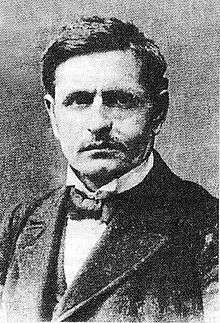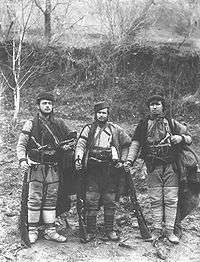Andon Kyoseto
| Andon Kyoseto | |
|---|---|
 A photograph of Andon Kyoseto | |
| Born |
1855 Golozinci, Ottoman Empire |
| Died |
September 10, 1953 Blagoevgrad, Bulgaria |
| Organization | IMARO |
Andon Lazov Yanev (Bulgarian: Андон Лазов Янев), nicknamed Kyoseto, was a Bulgarian[1] revolutionary and a freedom fighter of the Internal Macedonian-Adrianople Revolutionary Organization (IMARO).
Biography
Early years
Andon Kyoseto was born in 1855 in the village of Golozinci, Manastir Vilayet in Ottoman Empire. Until the age of 16, he worked as a shepherd with his two brothers and his two sisters. After his father was arrested and taken away to Thessaloniki, they moved in Veles into the house of their uncle. In Veles, Andon killed an eminent Turk and escaped to Thessaloniki, where he joined the revolutionary organization IMARO. At the beginning, he started to execute simple tasks that were assigned to him by the organization. He met Dame Gruev who became his superior and ordered him to do certain tasks for the organization. Later, he worked as cabman of Doctor Hristo Tatarchev in order to mask his illegal activities. At that time, his brother Nikola, who came to Thessaloniki, placed himself in the service of the Turkish authorities. At the suggestion of Andon Kyoseto, the organization killed his brother, so that he could not betray the organization. Andon also participated in the execution the Serbian teacher Peychinovich in Thessaloniki. With the help of Argir Manasiev, he executed the grecophille Tsitso from the town of Gevgelija. He returned to Thessaloniki, but only for a short time, because the Turkish authorities started investigations against him. Together with the revolutionary band of Iliya Karchovaliyata and Mihail Apostolov Popeto, they collected money from eminent inhabitants of the village of Gorno Brodi, and then they toured the region of Kilkis. There, Andon Kyoseto together with few of his friends, kidnapped the son of a rich man, and after 25 days he received 1000 lira for the ransom. Because of certain misunderstandings, his revolutionary band got arrested in Bulgaria. Gotse Delchev and Anton Bozukov helped their release. During his stay in Sofia, he executed the orders of Gotse Delchev. Later, Andon Kyoseto, Gotse Delchev and Mihail Apostolov Popeto made an unsuccessful attempt to take money by the kidnapping of a bey from Strumica. In 1897, together with Mihail Apostolov Popeto, he organized a revolutionary band, which operated in the regions of Kilkis, Dojran, Gevgelija, Ano Poroia, Maleševo, and Strumica. After the murder of the Romanian publicist Ştefan Mihăileanu, and the rumors of the coming war between Bulgaria and Romania, they went to Kyustendil and then to Sofia. There he was visited by the representative body of the Revolutionary Organization and had meetings with Gotse Delchev, Boris Sarafov, Mihail Gerdzhikov and others. Until the murder of Mihail Apostolov in March 1902, Andon Kyoseto was a leader of a revolutionary band in the region of Strumica, and later in the region of Kilkis. From 1900 he had contacts with Yane Sandanski. In 1901, he participated in the Miss Stone Affair.
After the uprising

During the Ilinden-Preobrazhenie Uprising, Andon Kyoseto was ordered, together with Gyorche Petrov and Luka Ivanov, to lead a revolutionary band in the region of Prilep. In the village of Trojaci, he initiated a minor battle against the Turkish military and after he split with Gyorche Petrov, Luka Ivanov and Pere Toshev, he went to the region of Veles. On October 17, 1903, before leaving the village of Skačinci, Andon Kyoseto together with 30 freedom fighters was engaged in a battle on "Klepata" against 500 Turkish soldiers. Boris Sarafov and his group of 70 freedom fighters then came and struck the Turkish military from the rear. Only four freedom fighters were killed, as opposed to 65 casualties on the Turkish side. The bands managed to escape during the night. They also escaped two ambushes set by Turkish soldiers. From the village of Prosenikovo, they headed to the border with Bulgaria and arrived in Kyustendil in the middle of December, 1903.
In the Balkan Wars, Andon Kyoseto, Yonko Vaptsarov, Georgi Zankov, Toshe Kolagov, Tasko Kocherinski, Mihail Chakov, Lazar Topalov, Stefan Chavdarov, Peyo Yavorov and others, formed a revolutionary band that was headed by Hristo Chernopeev. The band accompanied the 27-th Chepinski regiment on its attack on Mehomiya. Afterwards, Andon Kyoseto served in the headquarters of the 13-th Kukush Section.[2]
After the First World War Kyoseto moved to Bulgaria and settled in Gorna Dzumaya. After WWII the Yugoslav government submitted a memorandum to the UN, where the population in Bulgarian Macedonia was declared a "Yugoslav minority", persecuted and terrorized by the authorities in Sofia. Prominent old VMRO revolutionaries as Kyoseto, announced a special resolution against the Yugoslav claims.[3] Andon Kyoseto died in Blagoevgrad in 1953.
References and notes
- ↑ "I spoke in Turkish so that they did not know we were Bulgarians", Memories of Andon Kyoseto, Macedonia in Flames, Sofia, 2003
- ↑ "Македоно-одринското опълчение 1912-1913 г. Личен състав", Главно управление на архивите, 2006, стр.405.
- ↑ Германов, Стоян, Македонският въпрос 1944 - 1989. Възникване, еволюция, съвременност. София, 2012, стр. 134.
Sources
- Спомени на Андон Кьосето в "Илинденско-Преображенското въстание 1903—1968. Въстанието в спомените на участници в борбата", Издателство на Националния съвет на Отечествения фронт, София, 1968 г.
- Спомени на Андон Кьосето в "Македония в пламъци", ИК Синева София, 2003 г.